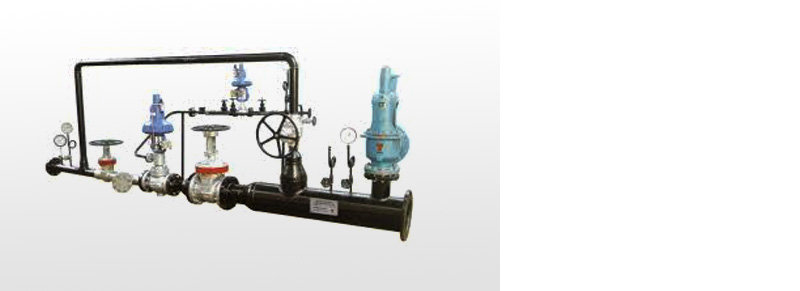Pressure Reducing Stations Manufacturers And Supplier

Pressure Reducing System are used to reduce from high pressure to low pressure at different stages. Pressure Reducing System ensures safety and precise control of pressure and flow. Pressure Reducing System are highly recommended for high flow application like high capacity boilers, reactors, pilot plants, Autoclaves etc. Diaphragm or Piston type of regulators are used in Pressure Reducing System.
Boiler pressure reducing systems, also known as Pressure Reducing Stations (PRS), are used to lower the high pressure of steam or gas from a boiler to a lower, usable pressure for specific applications. These systems are crucial for ensuring safety, precise control of pressure and flow, and efficient operation in various industrial processes, including those involving high-capacity boilers.
Purpose :
Boilers often generate steam at higher pressures, which may not be suitable for all downstream equipment or processes. A PRS is installed to reduce this high pressure to a more manageable level, often matching the specific requirements of the application.
Components :
PRS typically includes components like pressure reducing valves, pressure gauges, safety valves, and isolation valves, all arranged in a specific configuration to achieve the desired pressure reduction.
Functionality :
The pressure reducing valve, a key component, senses the downstream pressure and modulates its valve opening to maintain the desired pressure, even as the upstream pressure fluctuates.
Benefits :
Safety : Reduces the risk of damage or failure of equipment due to high pressure.
Efficiency : Ensures optimal pressure for processes, improving efficiency and reducing waste.
Reliability : Provides a consistent and reliable supply of steam or gas at the desired pressure.
Cost Savings : Minimizes energy consumption by using only the necessary pressure.
Applications :
PRS are widely used in various industries, including power plants, refineries, chemical processing, and other industrial settings where steam or gas is utilized.
Types of PRS :
There are different types of PRS, including self-operated and pilot-operated, with various valve designs like globe or angle style bodies.
Regulations :
In some regions, specific regulations or standards (like the Indian Boiler Regulation) may govern the design and installation of PRS.
Steam Pressure Reducing Stations FMPRS - Forbes Marshall In essence, a boiler pressure reducing system is a vital component for managing and utilizing steam or gas effectively and safely in a wide range of industrial applications.
Have you ever thought about why a technical consultant suggests buying a high-pressure boiler? It then reduces the pressure by using the pressure reduction valve (PRV) to the required level as per the process requirement. In general observation, it seems like a cost increasing step since you need to buy an extra device (Pressure Reduction System) and other extra fittings to install in the steam line.
Let’s dig a little deeper, whether using a PRS is practically feasible or not.
Steam generation at high pressure helps you to reduce the initial investment cost since at high pressure the specific volume of steam is lower than that at low pressure, which requires a small diameter pipe to carry the steam and reduces the cost associated with the pipe , which leads to a reduction in the initial investment cost. The high-pressure steam generation allows relatively less carryover and provides better-quality steam, as at low pressure, carryover is more likely to occur. Using a high-pressure boiler allows you to use the steam in different applications at different pressures by using the PRV. It also provides the flexibility for variable load. A sudden increase in load reduces the boiler pressure and increases the carry over and moisture content in the steam.
The PRV eliminates this and allows constant pressure to be maintained in the boiler. Furthermore, generating steam at high pressure is relatively cheaper than using the low-pressure boiler, so it reduces fuel consumption.
Now we have a brief idea of what benefits PRS serves. Any porous plug or orifice valve which reduces the cross-section area across the flow, works as a pressure reducer, but during the fluctuating loading, the outlet pressure of the valve will also fluctuate, which is not desirable, so to eliminate the above issue, we use the PRV, which provides a constant pressure during the variable loading also.
Let’s look more closely at what the technical data suggests :
A pressure reducing valve is a regulating valve that maintains the steam pressure at the outlet at a certain fixed, prescribed level that is lower than the inlet pressure. The PRV not only reduces the pressure but also controls the flow by load fluctuation dynamically. Therefore, using the change of state of steam caused by adiabatic steam expansion, not only the pressure changes but the temperature, specific volume, and latent heat also change.
Effects caused by PRS :
Quality improved of steam: Pressure reduction is the use of adiabatic steam expansion. Since the latent heat of steam changes as pressure changes, dryness fraction increases.
For example : if the saturated steam at pressure is 10 kg/cm2 with a 95% dryness fraction is reduced to 3 kg/cm2.
Enthalpy of steam at inlet of PRS = 181.2 + 0.95*481.8 = 638.91 kcal/kg And the dryness fraction at the outlet,= (638.91-133.4)/516.9 = 0.977= 97.7%
Now we can see a 2.7% increment in the dryness fraction. which simply means less condensate will form inside the pipe and more steam will reach the process.
Reduction in piping cost. : As mentioned above, the PRV allows the generation of steam at high pressure, and at high pressure the density of steam is high, which requires less space, so high pressure steam can be carried in a small diameter pipe as compared to low pressure steam.Considering the above example,
The density of steam at 10 kg/cm2 = 5.049 kg/m3
Velocity of steam in pipe = 30 m/s
Capacity of boiler = 2000 kg/hr
Then, the pipe required to carry the high pressure (10 kg/cm2) steam at a rate of
2000 kg/hr is,
Steam capacity (kg/s) = density * area velocity 2000/3600 = 5.0490.785*D2 * 30 Inner diameter D = 68.38 mm.
And pipe required to carry the low pressure (3 kg/cm2) steam at the rate of 2000 kg/hr is,
The density of steam = 1.622 kg/m3
Velocity of steam = 30 m/s
2000/3600 = 1.6220.785D2 *30
D = 120.4 mm
So, by using the PRV before the process, a large piping coat can be saved since a lower diameter pipe will be required.
Reduced Carry Over : Low pressure boilers are more prone to carryover. The PRS reduces the boiler carry over by allowing us to generate the steam at high pressure and ensure the contaminants free steam reaches the process. Since carry over reduces the life of the valves, strainers, and pipes, so PRS also improves the life of the system indirectly.
Even heating conditions : PRV keeps the outlet pressure constant and stabilizes the heating conditions, which ensures uniform productivity by maintaining the constant temperature.
Single boiler for different applications : with the help of PRV, a single boiler of high pressure can be used for different applications at different pressures.
For example, if a steam process unit has three different operations in which steam is required at 5 kg/cm2 pressure, 6 kg/cm2, and 4 kg/cm2 with a capacity of 2 TPH, then in this case, instead of three different boilers, you can choose a single boiler of 6 TPH capacity and pressure greater than 6 kg/cm2.
Precautions During PRV Installation: It is also important for you to know whether the installation of PRV is appropriate or not. Since an improper location of PRV may cause you losses and would not have any benefits. Some of the basic factors you should take into consideration.

